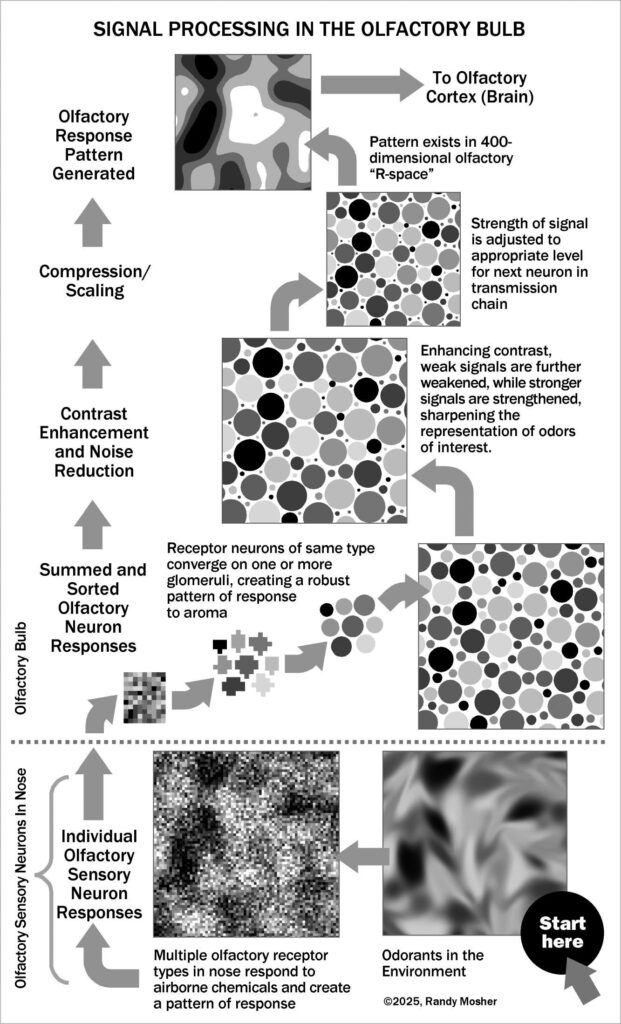Part One: Signal Processing
Unlike manufactured systems, our senses can’t rely on highly accurate and linear sensors to convert external stimuli into usable signals. Biological systems are inherently variable, noisy and limited in range, yet we need clear and accurate information to guide our behavior. How do we manage to do this?
Over the eons, life has evolved many clever strategies for getting useful information out of sloppy sensors. One technique is to simply use mass numbers of them, averaging out their individual eccentricities and extending their range. A single olfactory neuron holds about 25,000 receptors; each of our more than 2.6 million receptor neurons may send a signal every few milliseconds. That’s a whopping lot of information.
Another tool employs signal processing to clean up noisy, low-contrast signals into something clear and reliable. It’s remarkably similar to the kinds of signal processing used in electronics for audio and other signals.While this begins right at the level of the receptors, the bulk of it takes place in the olfactory bulb (OB), a kidney-bean-sized outgrowth of the brain into which signals from olfactory neurons feed, sorted by type. Despite its tiny size, the OB is a powerhouse capable of an amazing amount of signal processing despite the fact that signals flow through only one of two types of neurons from input to output. Nonetheless, its workings are dazzlingly complex, far beyond what I can cover in this brief post. Or that I—or anyone at this point—fully understand.
To back up a little, the olfactory systems for almost all animals work in what is called a combinatorial manner. Multiple receptors interact in various ways with multiple odor chemicals, creating a complex pattern the brain uses to recognize specific odors. It is this receptor response pattern that the olfactory bulb processes, reducing noise, enhancing contrast, normalizing signal levels and more.
The brain must store some aspect of these patterns in order to recognize them, but only for that purpose, as it is incapable of breaking them down into their component parts. Instead, we attach various bits of meaning to them: Like/dislike, identity, context, meaning and more. These things come flooding back to us when we make a match.
In addition to the through-lines (mitral and tufted cells), the OB contains several types of cells known as interneurons assisting with the processing, and close to the output, talking to the olfactory cortex in the brain. Its small size and inaccessible location in the head makes it hard to study. To make progress, scientists employ one of the more interesting disciplines I ran across in my research. Known as computational neurobiology, this approach studies the anatomy plus the inputs and outputs of neural circuitry, then ties to program it all in software. When the computed circuitry matches all of this, then there is a good likelihood that this is how it works. That’s the idea anyway.

Start at the lower right to follow a stylized representation of the kind of processing that occurs in the olfactory bulb.
The attached visual tries to depict not the circuitry, but what is happening to the signal as it moves from the input end of the OB to the output. As the book was getting ridiculously long, some of the visuals, like this one, had to be cut. I’m reproducing it here as I think it is interesting and helps make sense of this fascinating process.
I was fortunate to have had an informative conversation with Thom Cleland, a scientist doing some of this computational work. He was kind enough to make a few suggestions and say that what I present here is “…a pretty good graphic,” although it simplifies things quite a bit to better convey some of the OB’s central functions.
In a future post, I’ll discuss my representation of the little dance the olfactory bulb does with the brain to recognize those odor response patterns.
Here’s the reference for the computational work:
Thomas A. Cleland and Ayon Borthakur, “A Systematic Framework for Olfactory Bulb Signal Transformations,” Frontiers in Computational Neuroscience 14 (2020), https://doi.org/10.3389/fncom.2020.579143.

